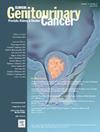体表面积校正对肌肉浸润性膀胱癌患者肾功能顺铂适格性的意义
IF 2.3
3区 医学
Q3 ONCOLOGY
引用次数: 0
摘要
无体表面积(BSA)校正的肌酐清除率(CCr)≥60 mL/min通常用于确定膀胱癌患者顺铂(CDDP)的适格性。然而,由于CDDP剂量是根据BSA计算的,因此,在不校正BSA的情况下应用肾功能可能会低估CDDP的适用性,尤其是低BSA患者。本研究的目的是确定BSA纠正肾功能是否影响CDDP资格和肿瘤预后的决定。患者与方法回顾性分析294例肌肉浸润性膀胱癌患者接受铂基新辅助化疗(NAC)并行根治性膀胱切除术的资料。BSA低于和高于中位BSA值(1.70 m2)的患者分为低BSA组和高BSA组。在第一个NAC周期接受CDDP减量≥20%或卡铂替代的患者被归类为“CDDP不足”受体。“cddp合格性低估”定义为经BSA校正的CCr 60 mL/min/1.73 m2,未经BSA校正的CCr 60 mL/min。使用多变量分析评估BSA与cddp不足的关系。此外,还评估了低bsa组和高bsa组之间的临床结果差异,即癌症特异性生存(CSS)和对NAC的客观反应率(ORR)。结果低bsa组比高bsa组更容易低估scdp -适格性(17% vs 0%;P & lt;措施)。多因素分析显示,低bsa与CDDP不足的风险独立相关(优势比,2.07;P = .012)。低bsa组从NAC开始的CSS明显短于高bsa组(风险比,2.24;P = .002)。低bsa组NAC的ORR也显著降低(40.8% vs. 57.1%;P = .007)。结论在确定低BSA患者是否适合使用CDDP治疗肾功能时,应采用标准BSA校正的肾功能值,以防止不适当的减量。本文章由计算机程序翻译,如有差异,请以英文原文为准。
Significance of Body Surface Area Correction for Cisplatin Eligibility Based on Renal Function of Patients With Muscle-Invasive Bladder Cancer
Introduction
Creatinine clearance (CCr) ≥60 mL/min without body surface area (BSA) correction is commonly applied to determine the cisplatin (CDDP) eligibility of patients with bladder cancer. However, since CDDP dosages are calculated according to BSA, there is concern that applying renal function without BSA correction may underestimate CDDP eligibility, especially of patients with low BSA. The purpose of this study was to determine whether BSA correction for renal function affects the decision of CDDP eligibility and oncological outcomes.
Patients and Methods
The data of 294 patients who received platinum-based neoadjuvant chemotherapy (NAC) and underwent radical cystectomy for muscle-invasive bladder cancer were retrospectively analyzed. Patients with BSA below and above the median BSA value (1.70 m2) were divided into low-BSA and high-BSA groups. Patients who received ≥20% dose reduction of CDDP or replacement by carboplatin at the first NAC cycle were categorized as “inadequate-CDDP” recipients. “CDDP-eligibility underestimation” was defined as CCr with BSA correction >60 mL/min/1.73 m2 while CCr without BSA correction <60 mL/min. The association of BSA with inadequate-CDDP was evaluated using multivariate analysis. Additionally, differences in clinical outcomes, namely cancer-specific survival (CSS) and objective response rate (ORR) to NAC, between the low- and high-BSA groups were evaluated.
Results
CDDP-eligibility underestimation was more frequent in the low-BSA group than in the high-BSA group (17% vs. 0%; P < .001). Multivariate analysis revealed that low-BSA was independently associated with the risk of inadequate CDDP (odds ratio, 2.07; P = .012). CSS from initiation of NAC was significantly shorter in the low-BSA group than in the high-BSA group (hazard ratio, 2.24; P = .002). The ORR for NAC was also significantly lower in the low-BSA group (40.8% vs. 57.1%; P = .007).
Conclusions
When determining CDDP eligibility for renal function in patients with low BSA, renal function values corrected by standard BSA should be applied to prevent inappropriate dosing reductions.
求助全文
通过发布文献求助,成功后即可免费获取论文全文。
去求助
来源期刊

Clinical genitourinary cancer
医学-泌尿学与肾脏学
CiteScore
5.20
自引率
6.20%
发文量
201
审稿时长
54 days
期刊介绍:
Clinical Genitourinary Cancer is a peer-reviewed journal that publishes original articles describing various aspects of clinical and translational research in genitourinary cancers. Clinical Genitourinary Cancer is devoted to articles on detection, diagnosis, prevention, and treatment of genitourinary cancers. The main emphasis is on recent scientific developments in all areas related to genitourinary malignancies. Specific areas of interest include clinical research and mechanistic approaches; drug sensitivity and resistance; gene and antisense therapy; pathology, markers, and prognostic indicators; chemoprevention strategies; multimodality therapy; and integration of various approaches.
 求助内容:
求助内容: 应助结果提醒方式:
应助结果提醒方式:


